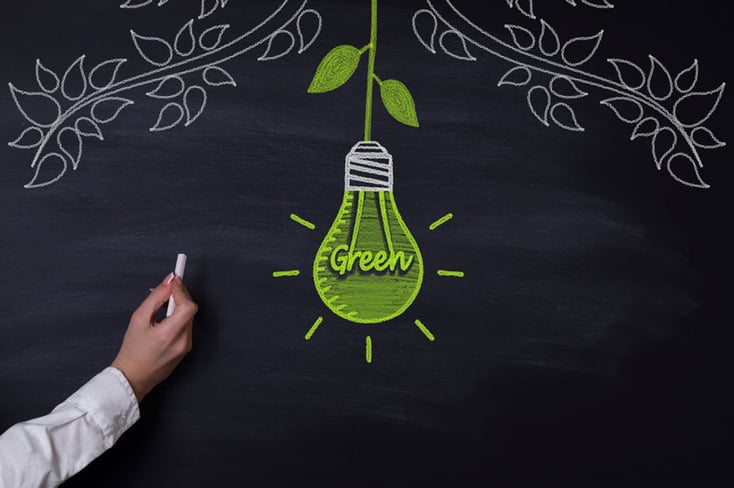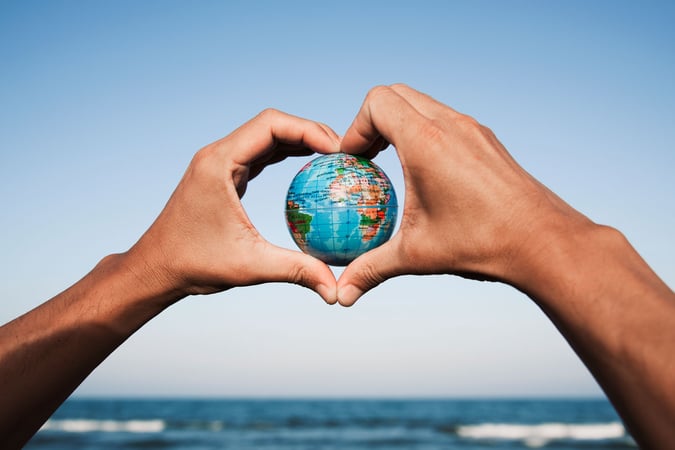Today many people are discovering that living a life that is eco-friendly is not only better for the planet, it might be better for their health and their wallet. If you're the type of person who likes to save money, chances are you already are going "green." Being green doesn't have to include installing solar panels and buying an electric car - although both of those are great steps to living an eco-friendly lifestyle. There are smaller, everyday things you can do that can add up to big savings while still allowing you to be environmentally conscious.

Here are 24 things you can do right now to save money by going green!
-
Paperless billing. Bills will always be a headache, but they don't have to be clutter around your home anymore. Switching to paperless billing has a few benefits. First, it lowers the odds of losing bills in the mail and possibly getting the electricity cut off right before the big game. Second, some companies offer a discount for paperless billing because it saves them money on stamps and printing.
-
Ditch the disposable razors. Ever think about the amount of plastic you throw away from shaving? Few of us want to go back to the straight razor, but you can make a compromise. There are monthly paid subscriptions to online shave clubs that will send you up to five new blade cartridges each month. You not only get a fresh blade, but you are also throwing away a fraction of the plastic. Most online shave clubs will get your first month free (just pay shipping). Then your subscription is just a few bucks a month.
-
Install low flow shower heads. Today’s low flow shower heads can help significantly reduce the water flow without reducing water pressure. Back in the day you could either have a great water pressure shower or a water saving shower… but today you can have both! You may also save on energy costs.
-
Replace your light bulbs with LED lights. For a small upfront investment in LEDs you can save hundreds or even thousands of dollars in energy costs over the lifespan of these bulbs. LED bulbs can last up to 10 years! Try purchasing them on sale and replace them as needed.
-
Use rechargeable batteries. You can use rechargeable batteries for most of your gadgets, remotes and smoke detectors in the house. Rechargeable batteries keep dead batteries out of the landfill and can save you money in the long run. Find them on sale and build your stockpile over time.
-
Quit buying bottled water! Bottled water might not be much better than your typical tap water. It might be convenient, but it could also contain plastic toxins from the bottles and it can leave a trail of plastic waste. Get a water filter for your faucet and a reusable water bottle to save money and help reduce plastic waste. Assume a 16 oz. bottle of water is just $1, sounds like a great price, right? Well, that’s $20.48 a gallon! You wouldn’t pay that for gasoline, why would you pay that for water?
-
Make your own cleaning solutions. Most store-bought cleaners are full of potentially harmful chemicals you really don’t want to poison your home. Plus, they can be very expensive, especially if you buy name brands. The good news is there are tons of great cleaning formulas you can make at home that work just as well, and cost just pennies on the dollar to make, for example, plain white vinegar can be mixed with water to make a safe cleaning solution.
-
Install a programmable thermostat. This handy little device allows you to program your heat or AC to come on right before you get home and turn down while you are asleep or away from home. This can not only save you money on your utility bills, but it can also help save energy and reduce pollution.
-
Put a brick in your toilet tank. This only works for older toilets, newer toilets are mostly low flow, but you can make your old toilet into a low flow toilet by putting a brick (wrapped in a waterproof plastic bag) or a recycled plastic bottle full of sand into your tank. This will displace the water in the tank and decrease the amount of water wasted on every flush. Those gallons of water add up every day, month and year.
-
Buy recycled paper products. Unbleached recycled paper products work just as well as name brands of toilet paper, computer paper and other paper products but save tons of chlorine pollution from the bleaching process. Plus, you will help conserve millions of trees and gallons of water.
-
Turn down the water heater. Whether showering or washing up, we rarely need tap water as hot as it can get, so why not turn down the hot water heater? The typical setting is around 140 degrees Fahrenheit and by lowering to 120 degrees can save on water heating costs.
-
Use reusable shopping bags. Paper or plastic? These used to be your only choices. Now you can choose neither! Some stores offer a discount if you bring your own shopping bag. Plus, reusable bags are generally stronger and protect the purchased items better than disposable plastic bags.

-
Use washable rags instead of paper towels. Use old rags or kitchen towels to clean up messes around the house. This not only saves you a few dollars, but also saves trees and keeps paper out of the landfill.
-
Fix water leaks. A leaky faucet can leak about 3 gallons of water a day, while a leaky toilet can leak about 22. Fixing your water leaks now saves you the money, and the drip...drip...drip... irritation.
-
Turn off the tap. In many homes it has become common practice to leave the tap running while washing your face, brushing your teeth, doing the dishes, and so on. Think of it like turning off a light when it’s not being used—it’s simple, causes no inconvenience, and saves money and resources.
-
Use cloth napkins. They are more durable and abandoning disposable napkins will save plenty of money over the years. Plus, it’ll reduce your trash output, which means less energy is used processing the waste. While it is good for the environment to use recycled paper napkins, the best option is to not have anything to recycle. Plus, cloth napkins can make dinner seem oh-so-fancy.
-
Use natural light. This might sound like your mom or dad, but always turn out the lights if you’re not in the room. Take advantage of natural light during the day by opening the curtains and/or blinds. Doing so can also help heat the room during the winter months. As mentioned before, when you need to use the lights, use energy-efficient light bulbs.
-
Avoid idling your car. Your vehicle might actually use more gas to idle for a mere 30 seconds than it does to turn it off and then restart it. Also, the huge amount of smog created by idling vehicles is a major polluter of the environment. It’s hard to do this when in traffic but the more times you can keep your car from idling will help the planet.
-
Buy second-hand items. These days you can buy almost anything — furniture, clothing, electronics—used and in good condition. This will reduce the overall consumer footprint and keeps more things from going to a landfill!
-
Replace HVAC filters. Regularly replace your furnace filter with a clean one so your heating and cooling system runs at higher efficiency, saving money and energy. It is recommended to replace the filters at a minimum every 4 to 6 months.
-
Recycle your old electronics. We all have discarded cell phones and chargers we don't want to throw out (don't!) but don't know what else to do with. You might be able to recycle them for cash at sites like: YouRenew.com and Gazelle.com. They will pay for used phones and other electronics. Even if you think your electronics have no value, remember that the parts in it are still valuable, and possibly toxic if not disposed of properly, so recycle your electronics. You can also check into donating cell phones to a local charity.
-
Take shorter showers. Taking long showers is a triple-whammy in terms of energy and water consumption. You're using the water heater to heat the water and wasting water by showering too long, plus you are using excess electricity to power the lights in the bathroom. So, the shorter the better. To conserve even more water, you can turn on the water to lather up, then turn the water off. You can wash up and then turn the water on again to rinse.
-
Do laundry more efficiently. Here are a few simple ways to be more efficient with laundry. Use cold water for everything — hot water requires a ton of energy. Dry your clothes on a “clothes line” or use a fold-out drying rack if you do not have access to an outdoor space to hang laundry. You can also toss a clean, dry towel in with dryer loads to help soak up water and require less time in the machine. Hand-wash items when you can. This will protect your delicates, save money on dry-cleaning and save you from wasting water to use the washer.
-
Ditch disposable bowls…and plates, and plasticware. Having nothing to wash up after a meal sounds great and it’s hard to resist but you are also increasing the pile of garbage left after dinner and that is not helping the planet. Plus, the less you spend on disposables the less you use them.
There are many misconceptions about living an eco-friendly lifestyle, especially the idea that it’s expensive and inconvenient. The truth is it can be easy being green. Help the planet by making one simple change at a time. Plus, there's a huge bonus: these small lifestyle changes can often save you money, too. Get started Today!







.png?width=144&height=134&name=2019_PCI_Logo_Footer_10_16_19%20(002).png)
